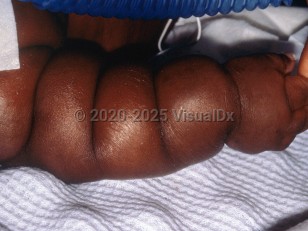Michelin tire baby syndrome
Alerts and Notices
Important News & Links
Synopsis

Michelin tire baby syndrome (MTBS), also known as Michelin tire syndrome, congenital symmetrical circumferential skin creases, congenital circumferential skin creases of the limbs, multiple circumferential skin creases, circumferential skin folds, and congenital diffuse lipomatosis, is a rare, benign, heritable connective tissue disease with a good prognosis. This disorder is characterized by multiple conspicuous circumferential skin folds involving the extremities and trunk.
This disorder was first named in 1969 by Ross et al. after the French tire manufacturer Michelin. Since this description, fewer than 40 patients have been described in the literature.
The cause of MTBS is currently unknown; hypotheses include abnormal elastin production or subsequent derangements in transport by lesional fibroblasts, metaplasia of dermal structures, or overgrowth of subcutaneous structures that then become differentiated as fat or muscle cells. MTBS may instead be a distinct clinical feature that reflects multiple etiologies. MTBS is thought to be associated with nevus lipomatosus or generalized smooth muscle hamartoma, although pseudo-Darier sign (transient piloerection and induration induced by rubbing in smooth muscle hamartomas) is usually negative.
MTBS is thought to have autosomal dominant inheritance, although recent evidence may suggest an autosomal recessive nature instead. Chromosomal mosaicism, balanced paracentric inversion of chromosome 7, and deletion of chromosome 11 have been reported and may be causative factors.
This disorder was first named in 1969 by Ross et al. after the French tire manufacturer Michelin. Since this description, fewer than 40 patients have been described in the literature.
The cause of MTBS is currently unknown; hypotheses include abnormal elastin production or subsequent derangements in transport by lesional fibroblasts, metaplasia of dermal structures, or overgrowth of subcutaneous structures that then become differentiated as fat or muscle cells. MTBS may instead be a distinct clinical feature that reflects multiple etiologies. MTBS is thought to be associated with nevus lipomatosus or generalized smooth muscle hamartoma, although pseudo-Darier sign (transient piloerection and induration induced by rubbing in smooth muscle hamartomas) is usually negative.
MTBS is thought to have autosomal dominant inheritance, although recent evidence may suggest an autosomal recessive nature instead. Chromosomal mosaicism, balanced paracentric inversion of chromosome 7, and deletion of chromosome 11 have been reported and may be causative factors.
Codes
ICD10CM:
D21.9 – Benign neoplasm of connective and other soft tissue, unspecified
SNOMEDCT:
239142006 – Michelin-tire baby
D21.9 – Benign neoplasm of connective and other soft tissue, unspecified
SNOMEDCT:
239142006 – Michelin-tire baby
Look For
Subscription Required
Diagnostic Pearls
Subscription Required
Differential Diagnosis & Pitfalls

To perform a comparison, select diagnoses from the classic differential
Subscription Required
Best Tests
Subscription Required
Management Pearls
Subscription Required
Therapy
Subscription Required
References
Subscription Required
Last Updated:10/09/2022
Michelin tire baby syndrome

